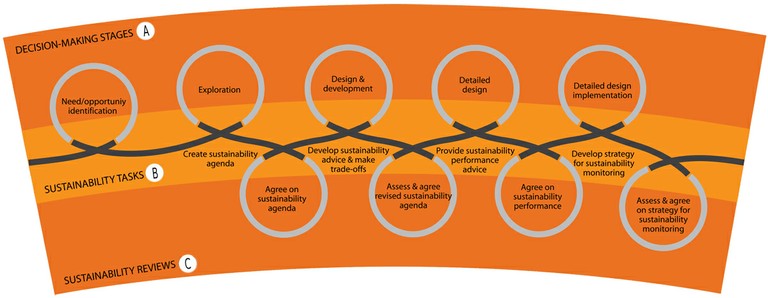Design and Development: The Urban Design Decision-Making Process
Click on the above diagram for more detailed information concerning the various stages of decision-making in urban design, including sustainability issues to consider at each stage.
The Urban Design Decision-Making Process is a significant part of the Urban Design Life Cycle of any urban development project. As an urban development project gets under way, decision-makers travel through the diagram from left to right, taking the stages step-by-step through the loops and curves of the iterative process. To see a chronological explanation of each stage of the process, click here.
The Urban Design Decision-Making Process can be divided into three lateral sections: Decision-Making Stages, Sustainability Tasks and Sustainability Reviews.
A) Decision-Making Stages
These signify the steps to be taken by two different decision-making teams when an urban development project is being carried out. The two teams are:
The Project Sustainability Group: comprises individuals who are able to work throughout the lifetime of the urban development project (e.g., local authority staff, developers, financiers/investors, those in the construction industry, residents). In some cases, particularly when the urban development project is small and/or the identified need or opportunity is still being investigated, the Group may consist of only one or two individuals, rather than an entire team. Furthermore, a leader should be appointed who has the appropriate skills to chair the Group.
The Development Team: comprises decision-makers who will directly be involved with the development of the urban development project, such as architects, designers, planners, developers, financiers/investors and landowners.
B) Sustainability Tasks
These are specific, sustainability-related activities that the two decision-making teams should engage in as they progress throughout the urban design decision-making process. Sustainability tasks put sustainability directly on the decision-making table (e.g., what it means for a particular urban development project, what issues are important) and make explicit the idea that decision-makers must consider sustainability in the design, construction, use and management and maintenance of their urban development project. For example, as the Development Team identifies a need or opportunity for an urban development project, they will begin to hold discussions with the Project Sustainability Group about what sustainability issues are deemed important for the design and development and detailed design stages of the project. From these discussions, a Sustainability Agenda will be created.
C) Sustainability Reviews
These represent opportunities in the urban design decision-making process for the two decision-making teams to evaluate progress-to-date on the urban development project, with particular attention paid to the progress made on the various sustainability tasks. As the Sustainability reviews are ‘signed off’, similar to soft gates in the Process Protocol, the two teams can move on to the next stage of the process. The first three reviews—Agree on sustainability agenda, Assess and agree on sustainability agenda and Agree on sustainability performance—provide the teams with an understanding of the agreed-upon priorities for designing and then constructing a more sustainable urban development project. The last review—Assess and agree on sustainability monitoring—gives the teams a strategy for assessing the urban development project during use, management and maintenance.

© Images Copyright Andrew Wooton 2008





